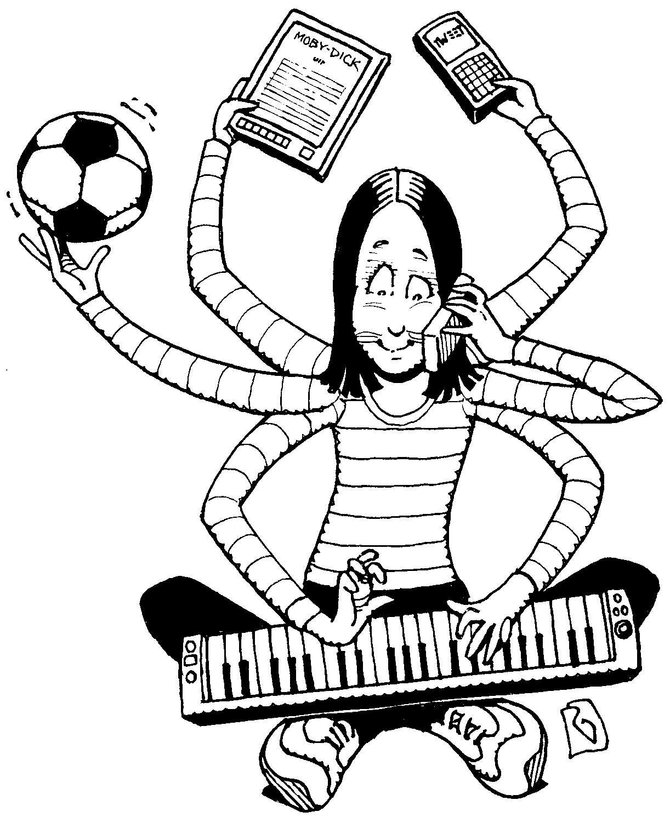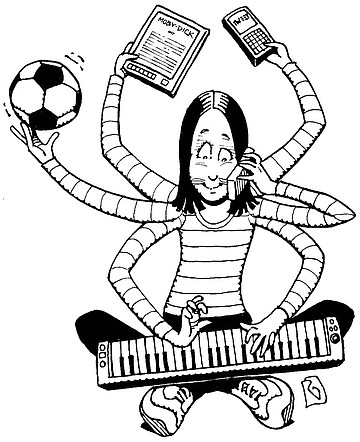 Facebook
Facebook
 X
X
 Instagram
Instagram
 TikTok
TikTok
 Youtube
Youtube

Hey Matt: My teenager always seems to be doing ten things at once. I can barely manage one or two. Is there something special about the teenage brain that makes them good multitaskers? — Mom Nancy, San Diego

Everybody knows teens have “different” brains, sometimes no brains. And that’s been proven scientifically. It’s generally accepted from years of research into the subject that teens’ brains are undeveloped and won’t reach “adulthood” until age 25 or 30. Scary, scary thought. Worse yet is the fact that the lagging lobe is the frontal, responsible mainly for judgment, long-term planning, and impulse control. So, yes, right off the bat, teens’ brains are different. But does this difference make them better multitaskers?
If my brain’s still working well, I think we handled multitasking in general several months ago. Can people actually multitask? No, no, science says. Two tasks, okay. Three or more, and things start to fall apart. Nothing much gets done accurately or in a timely way. We didn’t spend much if any time talking about teens in particular. But lately the science guys have pounced on the younger set for lots of investigation. Must be a ton of grant money out there for this type of thing. The issue of big concern is what happens to teens’ brains when they’re bombarded with so much media all at once and they multitask their way through the evening, and what this means for the brains of the future. Will we end up with a dazed population of ADD-afflicted adults who can’t concentrate on anything? Apparently that’s the grown-ups’ fear. And considering that the Kaiser Family Foundation says the average young person spends seven and a half hours a day with media of all types (up one hour a day from six years ago), maybe the concern is real.
So, Nancy, you say you can barely manage one or two things at once while your kids are like whirling dust devils. Right you are. People who did not grow up with media bombardment are pitiful multitaskers, science says.
One of the best known teen studiers is neuroscientist Jay Giedd of the National Institute of Mental Health. Since 1991 he’s been running the same teens through a functional MRI, which reveals in real time what segments of the brain are engaged in the task at hand. There’s about another decade to go on the study; by then he hopes to see a picture of exactly how the media onslaught changes the brain’s wiring over time. Past age five or six, the only brain changes that occur are in the neural pathways and connections, not the brain’s physical dimensions. Old, useless connections fade and beneficial connections are strengthened.
Giedd says today’s teens have a near-addictive attachment to their electronic buddies; they have trouble ignoring them. A signal for an incoming text will hijack their attention from other things. But it is the brain’s plasticity that offers big hopes for the future. Anyone raised in this media-rich atmosphere develops a brain adapted to that environment. Unlike Mom’s and Dad’s brains that could maybe read a comic book and watch Starsky and Hutch at the same time, today’s teens are adapting to a phone call while surfing the web while IMing a pal while perusing Facebook and doing Spanish homework. They can’t do any one of those things real well, but their brain circuits are adapting to that world. There aren’t any big signs that kids are headed for lifelong ADD. In fact, there are some aspects of the electronic world that scientists have found actually work to a teen’s benefit.
Parents will probably hate this, but studies done at the University of Rochester (NY) and elsewhere indicate that video games have plenty of potential benefits. Assuming you’re an average player, not a round-the-clock addict, video games can improve certain aspects of vision, cognition, concentration, visual short-term memory, “pure-brain multitasking,” and the generation of new ideas. The mental agility you need to play a game might spill over into your day-to-day life.
The more optimistic researchers suggest today’s kids might get the best of both worlds — an improved ability to multitask and the ability to zero in on a subject when the situation calls for it. Of course, the teen has to think a task is particularly important for him/her to make an effort to concentrate on it. That would determine how a smack-down between algebra homework and a tweet would end. But if a kid’s fairly well rounded, it’s likely s/he eventually will be able to pick out the cashews from the peanuts. Of course, the research is fairly new and some of it incomplete, so nobody’s making any grand predictions yet. Like teens themselves, it’s all a work in progress.


Hey Matt: My teenager always seems to be doing ten things at once. I can barely manage one or two. Is there something special about the teenage brain that makes them good multitaskers? — Mom Nancy, San Diego

Everybody knows teens have “different” brains, sometimes no brains. And that’s been proven scientifically. It’s generally accepted from years of research into the subject that teens’ brains are undeveloped and won’t reach “adulthood” until age 25 or 30. Scary, scary thought. Worse yet is the fact that the lagging lobe is the frontal, responsible mainly for judgment, long-term planning, and impulse control. So, yes, right off the bat, teens’ brains are different. But does this difference make them better multitaskers?
If my brain’s still working well, I think we handled multitasking in general several months ago. Can people actually multitask? No, no, science says. Two tasks, okay. Three or more, and things start to fall apart. Nothing much gets done accurately or in a timely way. We didn’t spend much if any time talking about teens in particular. But lately the science guys have pounced on the younger set for lots of investigation. Must be a ton of grant money out there for this type of thing. The issue of big concern is what happens to teens’ brains when they’re bombarded with so much media all at once and they multitask their way through the evening, and what this means for the brains of the future. Will we end up with a dazed population of ADD-afflicted adults who can’t concentrate on anything? Apparently that’s the grown-ups’ fear. And considering that the Kaiser Family Foundation says the average young person spends seven and a half hours a day with media of all types (up one hour a day from six years ago), maybe the concern is real.
So, Nancy, you say you can barely manage one or two things at once while your kids are like whirling dust devils. Right you are. People who did not grow up with media bombardment are pitiful multitaskers, science says.
One of the best known teen studiers is neuroscientist Jay Giedd of the National Institute of Mental Health. Since 1991 he’s been running the same teens through a functional MRI, which reveals in real time what segments of the brain are engaged in the task at hand. There’s about another decade to go on the study; by then he hopes to see a picture of exactly how the media onslaught changes the brain’s wiring over time. Past age five or six, the only brain changes that occur are in the neural pathways and connections, not the brain’s physical dimensions. Old, useless connections fade and beneficial connections are strengthened.
Giedd says today’s teens have a near-addictive attachment to their electronic buddies; they have trouble ignoring them. A signal for an incoming text will hijack their attention from other things. But it is the brain’s plasticity that offers big hopes for the future. Anyone raised in this media-rich atmosphere develops a brain adapted to that environment. Unlike Mom’s and Dad’s brains that could maybe read a comic book and watch Starsky and Hutch at the same time, today’s teens are adapting to a phone call while surfing the web while IMing a pal while perusing Facebook and doing Spanish homework. They can’t do any one of those things real well, but their brain circuits are adapting to that world. There aren’t any big signs that kids are headed for lifelong ADD. In fact, there are some aspects of the electronic world that scientists have found actually work to a teen’s benefit.
Parents will probably hate this, but studies done at the University of Rochester (NY) and elsewhere indicate that video games have plenty of potential benefits. Assuming you’re an average player, not a round-the-clock addict, video games can improve certain aspects of vision, cognition, concentration, visual short-term memory, “pure-brain multitasking,” and the generation of new ideas. The mental agility you need to play a game might spill over into your day-to-day life.
The more optimistic researchers suggest today’s kids might get the best of both worlds — an improved ability to multitask and the ability to zero in on a subject when the situation calls for it. Of course, the teen has to think a task is particularly important for him/her to make an effort to concentrate on it. That would determine how a smack-down between algebra homework and a tweet would end. But if a kid’s fairly well rounded, it’s likely s/he eventually will be able to pick out the cashews from the peanuts. Of course, the research is fairly new and some of it incomplete, so nobody’s making any grand predictions yet. Like teens themselves, it’s all a work in progress.
Comments